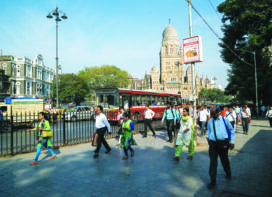 Developing intelligent systems through information integration and analytics: Current practices of customer-facing information provision are based on static forms and limited to that of metro schedule. Real-time information dissemination needs to be enabled on two levels: in-station localization and network level. In-station information would tap into real-time data available for different modes in the city. A network level information integration could be enabled by creating an ecosystem of data sharing amongst different modes of the city, where open APIs would help develop multiple dissemination channels. Both would help plan commute to avoid any incidental delays and tap into alternate route options. Strategies to disseminate this information for wider commuter groups to make metro access more inclusive can also be adopted.
Developing intelligent systems through information integration and analytics: Current practices of customer-facing information provision are based on static forms and limited to that of metro schedule. Real-time information dissemination needs to be enabled on two levels: in-station localization and network level. In-station information would tap into real-time data available for different modes in the city. A network level information integration could be enabled by creating an ecosystem of data sharing amongst different modes of the city, where open APIs would help develop multiple dissemination channels. Both would help plan commute to avoid any incidental delays and tap into alternate route options. Strategies to disseminate this information for wider commuter groups to make metro access more inclusive can also be adopted.
Data on temporal ridership shifts, incident-based ridership variation, general commuter and station profiles will help build more informed strategies for service planning and provision. Such agency-facing information systems will help identify and customize services for new catchment areas by identifying untapped trip generating points and customers demographics and accordingly help plan multiple aspects of the station, such as in-station commercial uses, infrastructure provision, information sharing, marketing, safety and management strategies.
Economic integration and addressing commuter needs: One of the challenges it faces is the need for transfers and the penalty associated, making it a more expensive option compared to existing systems such as buses. There is a need here to enable integrated payment and fare systems.
Integrated Payment:
The National Common Mobility Card (NCMC) model is set to change the payments ecosystem and will enable true, seamless, multimodal travel along with additional commercial retail applications. The true benefit of the system will be seen when it is adopted by existing commuting mode mixes. This includes all feeder systems, such as city bus services, intermediate paratransit (IPT) and non-motorized transport (NMT) modes, many of which operate as individual owner-operators. While the system is being piloted with individual agencies, there is a strong case to be made to further catalyze an ecosystem adoption.
Integrated Fare:
Fare integration reduces or eliminates what is known as a transfer penalty for a multimodal journey. With most public transport users purchasing multiple short distance tickets, the cost can be significantly more than a single ticket for a journey of equivalent distance; this extra cost is the transfer penalty.


 Consider a commuter journey from R V Road to National College Metro station, Bengaluru – a journey of three kilometres. Accessing R V Road is a one kilometre journey by bus, with another one-kilometre journey to access their destination from National College Metro Station. The table below shows that a multimodal journey by the metro is significantly more expensive than an equivalent direct journey by bus – 66% more costly. Fare integration recognises that a multimodal journey should not be treated as the equivalent of multiple short distance trips, and reduces the overall fare the commuter pays appropriately.
Consider a commuter journey from R V Road to National College Metro station, Bengaluru – a journey of three kilometres. Accessing R V Road is a one kilometre journey by bus, with another one-kilometre journey to access their destination from National College Metro Station. The table below shows that a multimodal journey by the metro is significantly more expensive than an equivalent direct journey by bus – 66% more costly. Fare integration recognises that a multimodal journey should not be treated as the equivalent of multiple short distance trips, and reduces the overall fare the commuter pays appropriately.
Considering the various challenges faced, technology and data-driven practices will enable urban rail systems to become more efficient, reliable and passenger-friendly, with consistently increasing ridership to meet designed levels of operations.
 TrafficInfraTech Magazine Linking People Places & Progress
TrafficInfraTech Magazine Linking People Places & Progress


